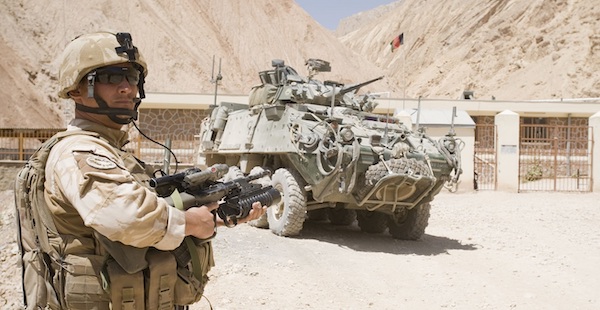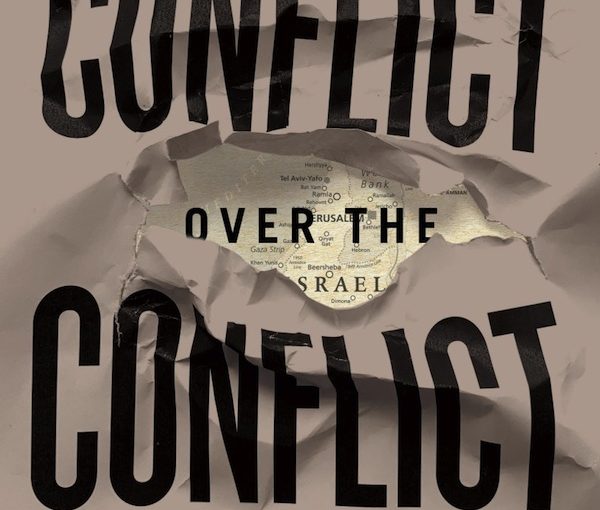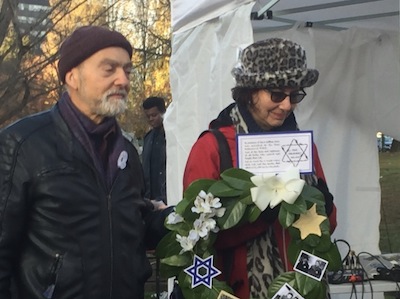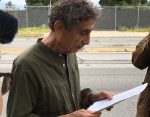Flame Towers, in the capital city Baku, reflect the forward-looking economy and the ancient Zoroastrian roots of the Azerbaijani people. (photo by Pat Johnson)
It is a Muslim-majority country where Jews proudly draw visitors’ attention to the fact that their synagogues and day schools receive government funding and require no security. It is a majority-Shiite country with a primarily Turkic population, where Turkish flags wave alongside Azerbaijani standards. Yet, among its closest allies is Israel, which a survey indicates is the second most admired country among its citizens. It provides 40% of Israel’s oil and receives vital security and defence cooperation from the Jewish state. One of the country’s greatest modern heroes is a Jewish soldier who died defending the country in 1992.
Azerbaijan is an enigma that defies assumptions, especially when it comes to its Jewish citizens, who have experienced almost nothing but neighbourliness from their Azerbaijani compatriots for two millennia.
Along with a small number of other Canadian journalists and community activists, I was a guest last month of the Network of Azerbaijani Canadians during an intensive weeklong immersion in the country, including its Jewish present and past.
I won’t pretend I didn’t have to Google Azerbaijan to place it alongside its Caucasus neighbours Armenia and Georgia, between the Black and Caspian seas, inauspiciously bordered by two rogue nations, Iran and Russia. Like many people, my knowledge of Azerbaijan was limited to its 30-plus-year conflict with Armenia over the disputed Karabakh region, a conflict that has led to allegations of war crimes, ethnic cleansing and atrocities on both sides.
We traveled to Karabakh, a place of ghostly, abandoned, war-destroyed cities and countrysides plagued by an estimated million landmines. Helmeted workers pace slowly through what were once farms in the almost unimaginably Sisyphean task of demining a half-billion square metres of land. (Israeli drones and artificial intelligence are helping the process.) We visited cemeteries and monuments, drove highways lined for kilometres with portraits of war dead.
In a distinct counterpoint to this carnage, we visited the country’s Jewish residents and learned of the history of Jews and non-Jews in this place, a story of almost unprecedented fraternity unusual for any country, not least a majority Muslim society in a place where ethnic and territorial conflicts, and the ebb and flow of empires, has conspired against peace.
A history of diversity
Azerbaijan was a deviation on the standard Silk Road route, and so people were long familiar with those from the west and the east. But its economy exploded in the latter half of the 19th century, when oil was discovered. By 1901, the region, part of the Russian Empire, was producing fully half of the world’s oil.
This ancient and modern history brought waves of Jews, beginning in biblical times. The oldest communities of Jews in Azerbaijan are known as Mountain Jews, or Kavkazi Jews, whose Persian-Jewish language is called Juhuri. Neither Ashkenazi nor Sephardi, the Mountain Jews maintain some Mizrahi traditions and their practices are heavily influenced by kabbalah. They trace their presence back to the Babylonian exile following the destruction of the First Temple, in 586 BCE, but these ancient communities have been joined in more recent times by other migrants.
Jews from neighbouring Georgia, where communities have also lived since the Babylonian exile, migrated to Azerbaijan during the first oil boom, in the late 19th century. After the 1903 and 1905 Kishinev pogroms sent terrified Jews from across the Russian Empire fleeing to the New World and elsewhere, a group of Ashkenazim moved from throughout the empire to Azerbaijan, drawn by its reputation for intercultural harmony.
Today, Mountain Jews make up about two-thirds of the country’s Jewish population. (Ballpark estimates are that there are 30,000 Jews in Azerbaijan.) Most Mountain Jews – 100,000 to 140,000 – now live in Israel and there is a significant population in the United States. Those who remain, however, deflect questions about why they have not made aliyah or migrated to Western countries.
“This is my homeland. Why should I leave?” asked Arif Babayev, the leader of the Jewish community in the city of Ganja, adding: “I don’t know what antisemitism is. I’ve never experienced it.”
The community of Qırmızı Qəsəbə, or Red Town, has been known as “Jerusalem of the Caucasus” and also as “the last shtetl in Europe.” It is said to be the only all-Jewish (or almost-all-Jewish community) outside Israel. The streets of the mountain village, in the northeast region called Quba, were quiet on a November Sunday. Many of the people who call the village home actually spend most of the year working in the capital city Baku, returning in summer to what amount to summer homes. The older community members and a few families stay year-round.
Three synagogues in the town survived the Soviet years – two still operating as congregations and one transformed into an excellent museum with original artifacts and in-depth exploration available on interactive screens where congregants once davened. The two synagogues, active on Shabbat and holidays, are intimate, magnificent structures. The Six Dome Synagogue, dating to 1888, was used as a warehouse and as a shmatte factory during the Soviet period and was restored and reopened for use in 2005.

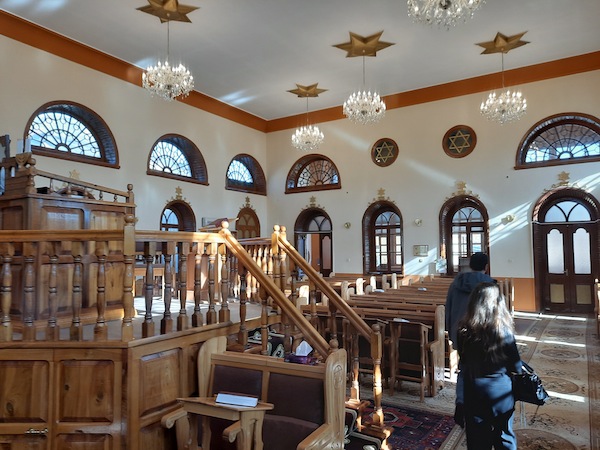
Throughout history, the Jews of the area worked in viticulture (their Muslim neighbours were ostensibly forbidden from alcohol-related tasks, though this is not a country with a large strictly observant religious population), tobacco growing, hide tanning, shoemaking, carpet weaving, fishing and the cultivation of the dry root of the madder plant, which is used in dyeing textiles and leather.
In the 1930s, there was a Stalinist crackdown on Judaism, but circumcision, kosher slaughter and underground Torah study survived. Since the end of the Soviet era and the dawn of independence, in 1991, Jewish life has both thrived and shrunk – many emigrated, but those who remained have revivified their cultural and religious roots.
In wealthy and modern Baku, signs of a flourishing Jewish community are found at two government-funded Jewish schools, each with about 100 students. They follow a government-created Jewish studies curriculum that includes Hebrew, Jewish history and tradition, as well as the official curriculum of the Azerbaijani education ministry. Like so many other places throughout the country, the school is festooned with photographs of the current president and his late father and predecessor.
The school’s leadership note that there is no security outside the institution, unlike in France or even Israel. The school is in a complex that includes a non-Jewish school and the students compete together in intermurals. Jewish and non-Jewish students celebrate the Jewish holidays together.
Nearby, the Sephardi Georgian congregation and the Ashkenazi synagogue share a building that was funded by the national government. The two sanctuaries are on different floors, each with their distinctive internal architecture and warm, inviting sanctuaries.
Ambassador optimistic
George Deek was the youngest ambassador in Israel’s history when appointed to head the embassy in Baku, in 2018. An Arab-Christian from a prominent Eastern Orthodox family in Jaffa, Deek was a Fulbright scholar at Georgetown University and held previous posts at Israeli missions in Nigeria and Norway. He is also, he noted, the Israeli diplomat geographically closest to Tehran.
The ambassador sees parallels between Azerbaijan and Israel, which are both young countries made up of people who are used to being bullied by their neighbours. Both peoples understand what it is to be small and to struggle to preserve one’s own culture, he said.
In addition to the large swath of Israel’s oil supply that comes from Azerbaijan, there is growing trade and cooperation between the countries across a range of sectors. In addition to strategic partnerships, they are sharing agriculture and water technologies in conjunction with the Arava Institute for Environmental Studies, in southern Israel. An Israeli company is building a Caspian desalinization plant and Israeli drip irrigation technology is being applied to Azerbaijani farms.
Tourism is a growing sector and Israel is a significant market: by next year, there will be eight flights weekly between Baku and Tel Aviv on the Azerbaijani state carrier, as well as regularly scheduled tourist flights on Israir.
Deek shared the results of a survey that seemed to provide proof of the historical and anecdotal things we had been hearing about the Azerbaijani connection not only to their Jewish neighbours but to the Jewish state. In a poll measuring Azerbaijanis’ positive opinions about other countries, Turkey came first and Israel second.
Despite all this upbeat news, and despite the fact that Israel has had an embassy in Baku almost since Azerbaijan gained independence, the diplomatic mission was not reciprocated, even as trade and person-to-person connections expanded. There is a range of geopolitical explanations for the lack of an Azerbaijani embassy in Israel and Deek told our group he hoped that Azerbaijan would soon be able to open one there. And, just a few minutes after we left our meeting with the ambassador, our guide received a phone call – Azerbaijan’s parliament had just approved a resolution to open an embassy in Israel.
The decision, after all this time, is due to a confluence of events. There had been fear of an Iranian backlash to more overt relations between Azerbaijan and Israel, but global disgust over the Iranian regime’s crackdown on anti-government protesters may have diminished Azerbaijani concerns. The close relationship between Azerbaijan and Turkey was probably another factor. With Turkish-Israeli relations back on a somewhat even keel after a chilly period, the time may have seemed right. With the long-simmering Karabakh conflict now concluded, as far as Azerbaijan is concerned, by the 2020 war that returned the region to Azerbaijani control, the country may be less wary of making waves among Muslim allies. That fear would likely be additionally assuaged by the Abraham Accords, which make warm Azerbaijani-Israeli relations less remarkable than they might have been just a few years ago. (Azerbaijan’s anti-Israel voting record at the United Nations is still a disappointment that some observers hope changes as ties grow.)
The tight relationship between Azerbaijan and Israel is, of course, viewed by Iran as a Zionist plot. Iran has both internal demographic and external security concerns about Azerbaijan. There are almost twice as many ethnic Azerbaijanis within the borders of Iran – about 15 million – than there are in the country of Azerbaijan, and the Islamic revolutionary regime doesn’t want any nationalist rumblings. Beyond this, the very existence of a secular, pluralist Azerbaijan stands as an affront to Iran. Azerbaijan is a majority Shi’ite country, like Iran. It is geographically and demographically small and, in the imagination of Iranian fundamentalists, it should be the next domino in the ayatollahs’ plan for regional domination. Instead, despite the familial ties across the Azerbaijani-Iranian border, intergovernmental relations are frigid.
What is it about Azerbaijan?
A new embassy. Burgeoning trade and tourism with Israel. Centuries of good relations between Jews and non-Jews. A level of comfort and security unknown to Jews in almost any other country, certainly any Muslim-majority place. What is it about Azerbaijan?
I asked a few people – religious leaders, a member of parliament, Jews and non-Jews – what the secret sauce is for the Azerbaijanis’ exceptional relations with their Jewish neighbours. No one had a pat answer.
It was people-to-people contact, one person told me. There was never a ghetto; Jews were integrated and part of a larger multicultural society. One theory is that, more recently, there have been lots of Jewish teachers in the school system, so Azerbaijanis get to know and respect Jewish people growing up. Another explanation is that Azerbaijanis view their national identity above their religious or other particular identities, so religious differences are not as divisive as in many places – a factor probably accentuated by decades of Soviet official atheism.
Rabbi Zamir Isayev, who leads the Georgian Jewish congregation in Baku, doesn’t have a simple explanation for why Azerbaijan, among the countries of the world, seems to be so good for the Jews. It’s simply in the nature of the Azerbaijani people, he says.
Azerbaijani history celebrates a number of notable Jews. The Caspian Black Sea Oil Company, which was central to the creation of the region’s dominant resource sector, was founded by Alphonse Rothschild, a French Jew, and other Jews have been involved in a range of resource and other sectors over the years.
In the short-lived government of the first independent republic of Azerbaijan, 1918 to 1920, the minister of health was a Jewish pediatrician, Dr. Yevsey Gindes. That government was also the first democracy in the Muslim world and among the first in the world to grant women the franchise. Like many countries that emerged from the collapse of the Russian Empire, Azerbaijan was quickly subsumed into the new Soviet Union.
Lev Landau, Azerbaijan’s 1962 Nobel Prize winner in physics, is widely fêted. Garry Kasparov, considered by some the greatest chess player of all time, is a (patrilineal) Jew from Azerbaijan. A long list of academics, athletes, musicians and business innovators have risen to the top of their fields in the country and abroad and are celebrated both as Azerbaijanis and as Jews. A hero from recent times seems to elicit an especially emotional connection.
The conflict with Armenia, which began in the late 1980s and culminated most recently in a 2020 war, remains understandably fresh in the national consciousness. Highways and villages display thousands of portraits of war dead and the Alley of Martyrs in the heart of Baku is the final resting place of 15,000 Azerbaijanis, many from the final throes of Soviet domination and the two wars with Armenia. Among the most visited graves at the sprawling memorial park is that of Albert Agarunov.
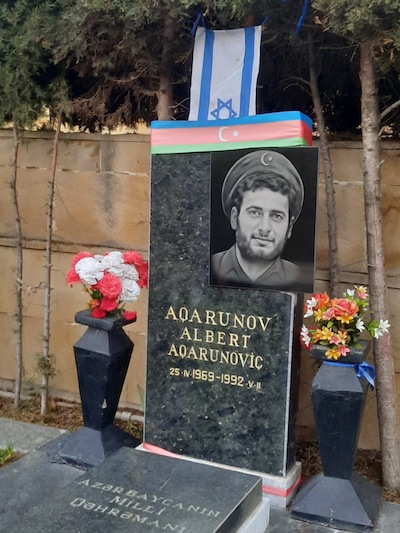
Agarunov was a young Jewish Azerbaijani who volunteered with his country’s defence forces and was a tank commander during the Armenian capture of the strategic Karabakh town of Shusha on May 8, 1992. The 23-year-old, already apparently such a legendary figure that the Armenians had put a bounty on his head, stepped out of his tank to retrieve bodies of slain Azerbaijani soldiers from the road when he was killed by sniper fire. Agarunov was posthumously named National Hero of Azerbaijan and was buried at the solemn national monument, in a service attended by both imams and rabbis. Today, Jews place stones on his grave and others place flowers.
In terms of Azerbaijani-Israeli relations, the large number of Azerbaijani-descended Jews who live in Israel create natural familial ties between the two places. Jewish remittances from Azerbaijani oil wealth helped purchase land in Palestine, an early portent of a connection between the two places. According to one museum piece, Jewish horse wranglers from the Caucasus made aliyah and became protectors of early kibbutzim and moshavim and helped put down the 1929 Hebron massacre, although I cannot find reference to this role online.
Whether that last detail is factual or not, what seems undeniable is that the story of Jews in Azerbaijan stands out as a model of coexistence and good neighbourliness in a world that has not always been so kind. This is a story that deserves to be told more widely.


